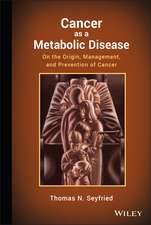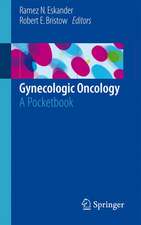Cell Death Signaling in Cancer Biology and Treatment: Cell Death in Biology and Diseases
Editat de Daniel Johnsonen Limba Engleză Paperback – 13 dec 2014
| Toate formatele și edițiile | Preț | Express |
|---|---|---|
| Paperback (1) | 703.06 lei 6-8 săpt. | |
| Springer – 13 dec 2014 | 703.06 lei 6-8 săpt. | |
| Hardback (1) | 956.81 lei 6-8 săpt. | |
| Springer – 17 noi 2012 | 956.81 lei 6-8 săpt. |
Preț: 703.06 lei
Preț vechi: 827.13 lei
-15% Nou
Puncte Express: 1055
Preț estimativ în valută:
134.59€ • 138.49$ • 113.45£
134.59€ • 138.49$ • 113.45£
Carte tipărită la comandă
Livrare economică 01-15 martie
Preluare comenzi: 021 569.72.76
Specificații
ISBN-13: 9781493901074
ISBN-10: 1493901079
Pagini: 424
Ilustrații: XVI, 408 p.
Dimensiuni: 155 x 235 x 22 mm
Greutate: 0.59 kg
Ediția:2013
Editura: Springer
Colecția Humana
Seria Cell Death in Biology and Diseases
Locul publicării:New York, NY, United States
ISBN-10: 1493901079
Pagini: 424
Ilustrații: XVI, 408 p.
Dimensiuni: 155 x 235 x 22 mm
Greutate: 0.59 kg
Ediția:2013
Editura: Springer
Colecția Humana
Seria Cell Death in Biology and Diseases
Locul publicării:New York, NY, United States
Public țintă
Professional/practitionerCuprins
Defective Apoptosis Signaling in Cancer.- The Warburg Effect and Beyond: Metabolic Dependencies for Cancer Cells.- Emerging Opportunities for Targeting the Tumor-Stroma Interactions for Increasing the Efficacy of Chemotherapy.- The Role of Autophagy in Drug Resistance and Potential for Therapeutic Targeting.- microRNAs in Cell Death and Cancer.- Targeting DNA Repair Pathways for Cancer Therapy.- Molecular Chaperones and How Addiction Matters in Cancer Therapy.- Sphingolipid Metabolism and Signaling as a Target for Cancer Treatment.- Leading Small Molecule Inhibitors of Anti-apoptotic Bcl-2 Family Members.- SMAC IAP Addiction in Cancer.- Harnessing Death Receptor Signaling for Cancer Treatment.- Proteasome Inhibition as a Novel Strategy for Cancer Treatment.- New Agents and Approaches for Targeting the RAS/RAF/MEK/ERK and PI3K/AKT/mTOR Cell Survival Pathways.- Activation of Immune-Mediated Tumor Cell Death by Chemotherapy.
Notă biografică
Dr. Daniel E. Johnson received his undergraduate training at North Park University and his doctoral degree in molecular biology from Princeton University. He was a postdoctoral fellow at the University of California San Francisco. In 1993 he joined the faculty at the University of Pittsburgh and the University of Pittsburgh Cancer Institute, where he is currently a Professor in the Departments of Medicine and Pharmacology & Chemical Biology. Dr. Johnson has served as a standing member on study sections for the National Institutes of Health and American Cancer Society, and is a long-standing Section Editor for the journal Leukemia. His research has focused on molecular mechanisms of apoptosis in leukemia and head and neck cancer, as well as the mechanisms of myeloid differentiation. He has placed particular emphasis on the translation of findings from his laboratory to the clinic, and together with physician scientist collaborators has helped develop ongoing trials in both acute myeloid leukemia and head and neck cancer.
Textul de pe ultima copertă
Defects in cell death pathways promote tumor development and progression, with potentially devastating consequences for cancer patients. Greater understanding of the defects occurring in cancer cells, and the unique characteristics of tumors which can make them vulnerable to cell death stimuli, offers tremendous opportunities for developing novel and effective anti-cancer therapies. In Cell Death in Cancer Biology and Treatment leading experts in the field provide a wealth of up-to-date knowledge regarding the molecular mechanisms and cell biological processes that control cell death. Each chapter also highlights recent advances in the translation of basic research findings into clinical trials. Beginning and established investigators alike will benefit from the thorough presentations of the most promising avenues for future development of cell death-based, anti-cancer strategies and agents.
The volume begins with a detailed description of many of the cell death defects that have been identified in human tumor specimens. The unique bioenergetics of cancer cells, and the influence of the tumor microenvironment, autophagy, and cellular microRNAs on cancer cell death are then discussed, along with current progress in targeting these distinctive features and processes. Additional chapters describe recent advances, and the therapeutic benefits of targeting DNA repair pathways, protein chaperones, sphingolipid signaling, Bcl-2 family members, IAPs, death receptor signaling, the proteasome, and survival signaling emanating from the PI3K/AKT and RAS/RAF/MEK/ERK pathways. Finally, recent discoveries are presented regarding interactions between the immune system and dying cancer cells and the potential for optimizing these interactions to maximize anti-cancer activities.
In summary, Cell Death in Cancer Biology and Treatment will be a valuable resource for scientists interested in cutting-edge understanding of aberrantcell death in cancer cells, and the multitude of innovative molecular targeting approaches that are actively being pursued to achieve selective activation of cell death in human malignancies.
The volume begins with a detailed description of many of the cell death defects that have been identified in human tumor specimens. The unique bioenergetics of cancer cells, and the influence of the tumor microenvironment, autophagy, and cellular microRNAs on cancer cell death are then discussed, along with current progress in targeting these distinctive features and processes. Additional chapters describe recent advances, and the therapeutic benefits of targeting DNA repair pathways, protein chaperones, sphingolipid signaling, Bcl-2 family members, IAPs, death receptor signaling, the proteasome, and survival signaling emanating from the PI3K/AKT and RAS/RAF/MEK/ERK pathways. Finally, recent discoveries are presented regarding interactions between the immune system and dying cancer cells and the potential for optimizing these interactions to maximize anti-cancer activities.
In summary, Cell Death in Cancer Biology and Treatment will be a valuable resource for scientists interested in cutting-edge understanding of aberrantcell death in cancer cells, and the multitude of innovative molecular targeting approaches that are actively being pursued to achieve selective activation of cell death in human malignancies.
Caracteristici
Describes state-of-the-art approaches and future opportunities for selective and efficient killing of tumor cells Discusses preclinical and clinical approaches Features development and application of novel agents and approaches Includes supplementary material: sn.pub/extras









